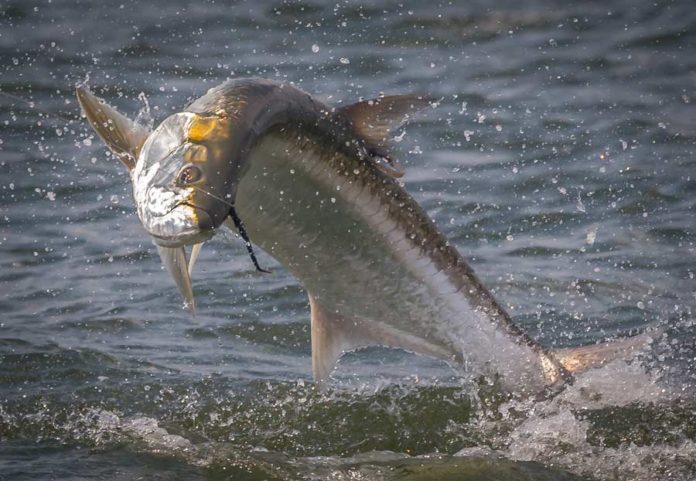Photo by Capt. Greg Dini
About four years ago, Capt. David Mangum was accompanying his crafts-obsessed six-year-old daughter on their weekly trip to the local Michael’s store, when something caught his eye. The Squirmle is a tapered-chenille “magical pet,” with two eyes glued to the front and a long piece of thin monofilament that allows you to pull the Squirmle along any surface, making it seem alive. To a tarpon guide—Mangum runs Shallow Water Expeditions, on the Florida panhandle—the fuzzy-worm toy looked like it might make a killer baitfish pattern, so he bought a couple packages.
Mangum brought the Squirmles home and simply tied one to a
hook. When he got out on his boat and saw how the fly undulated in the water,
he said, “Whoa!” He figured that any fish that saw that lifelike action would
almost certainly eat it. Unfortunately, after a few retrieves, the materials
started to come apart. After some experimenting, Mangum discovered that he
could increase the durability by burning the tail of the Squirmle with a
lighter, but they were still pretty fragile. The other problem was that
Squirmles don’t come in black, which is Mangum’s favorite color for tarpon
flies. The synthetic material didn’t take dye well, so he resorted to
hand-coloring them with a black Sharpie, which was both time-consuming and
messy.

Photo by Tom Rosenbauer
Tarpon Trial and
Error
For the next couple years, Mangum experimented on and off
with his new creation, and he became increasingly convinced that it was
something special.
“When tarpon ate it, I mean, they ate it,” he says. “There were no subtle sips or tentative takes.
They smashed it, with giant,
head-out-of-the-water eats.”
As he slowly let others in on what had become one of his main tarpon patterns, there were on-the-water discussions of what to call the new fly. Early candidates were Big Black Thing and Chenille O’Neal, but it was legendary Florida guide Steve Huff who dubbed it the Dragon Tail. The name is actually a clever pun: the most productive retrieve involves making one long pull, with no strips, followed by the angler dragging the fly through the water by sweeping the rod tip rearward. The conflation of dragon and draggin’ seemed to perfectly capture Mangum’s invention.
Having seen how well tarpon responded to the Dragon Tail, Mangum knew that it would work on a wide variety of species, but he couldn’t present the pattern to the wider world until he’d figured out how to make it more durable. He approached Jesse Haller, who runs the flies program for Orvis, for help. Jesse was able to work with a vendor to solve the durability issue and to create Dragon Tails in a variety of fish-catching colors. They are now available online and in shops around the country.
When I asked Mangum which species he’s caught on Dragon
Tails, he responded, “Everything I fish for,” including tarpon, snook, redfish,
false albacore, and largemouth bass. Others have reported great success with
striped and smallmouth bass, pike, and even big brown trout. It appears that
the Dragon Tail is posed to become the Banjo Minnow of the fly-fishing world.
(Although I don’t expect there to be a late-night infomercial about the fly.)
Once you see the sexy undulation of a Dragon Tail in the water, you’ll
understand why fish find it so irresistible.

Photo by Capt. Renee LeTourneau
Tying with Dragon
Tails
Tying with Dragon
Tails can be as easy or as complicated as you like; you can simply lash the
Dragon Tail to the hook and leave it at that. However, no matter what pattern
you’re creating, there are two steps that are absolutely necessary: creating a
base for the tail—to prevent fouling—and burning the very end of the tail. The
tail base, which some call a “schnarzel,” is little more than a loop of heavy monofilament
lashed to the top of the hook. As a tarpon guide, Mangum cannot risk the tail
fouling on what might be the only shot of the day. For extra protection against
this, he scuffs the rear end of the loop with sandpaper and uses five-minute
epoxy to secure the schnarzel to the Dragon Tail.
For the head of his standard Dragon Tail pattern, Mangum
uses Enrico Puglisi three-inch Craftfur Brush, which creates a nice profile and
pushes water ahead of the undulating tail. But you can really use anything you
want for the front of the fly: deer hair, webby hackle, or any synthetic fiber,
for example. Dragon Tails are still so new that we surely haven’t explored a
fraction of the possible combinations of materials, and it will be exciting to
see what tiers come up with when creating versions for different species.
Click here to see all available Dragon Tails for tying, as well as Mangum’s Dragon Tail.
Credit: Source link































